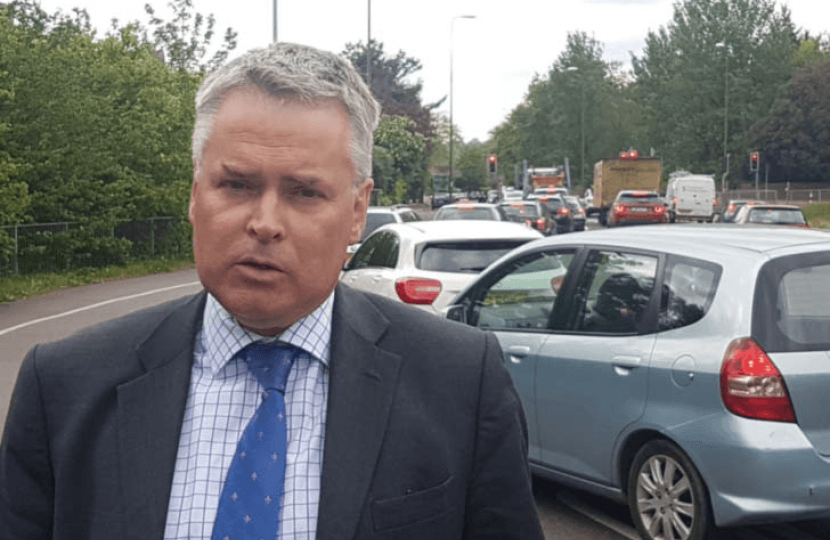
The meeting at the Pavilion Theatre to give an update on the proposals for upgrading the A27 was packed with standing room only for some of the 800 or so people who packed the hall. The meeting was organised by the A27 Working Group which is chaired by Councillor Tom Wye, and which I sit on along with Peter Bottomley, councillors and representatives from all political parties, local businesses and all the main residents groups along the route of the A27.
There were presentations from Highways England, the Chamber of Commerce and Worthing businessmen, Peter, me and the excellent BBC Sussex traffic expert Stephen Cranford. Frustratingly the project lead from Highway England Peter Phillips was unable to attend at the last minute as his wife had been taken ill on holiday and it is true to say that his replacements from the Agency responsible for the A27 did not handle questions well. Subsequently Tom Wye offered to provide follow up answers to outstanding questions and those submitted on the forms at the end of the meeting. Some of these have been answered and appear of the A27 section of my website and more will be added.
We have also published all the minutes of meetings of the A27 and the presentations we have been given which include some interesting data. This includes last week’s meeting when we heard from a representative of the South Downs National Park, a Ricardo employee on the impact of traffic on air pollution and Stephen Cranford has done some interesting number crunching on the cost of delays on commercial traffic caused by the Grove Lodge traffic lights which have become a bit of a ‘cause celebre’ and the meeting almost unanimously wanted to see scrapped. This is something I have been calling for over many years and questioned their effectiveness when they were first prosed by the then Highways Agency went ahead anyway.
As you can you can see from the figures provided from Stephen on my website he has calculated that if the Grove Lodge lights delay freight traffic by just ten minutes then based on official figures provided by the Freight Transport Association that costs almost £40,000 per day. That equates to around £1m a month and £120m over the ten years the lights have been in operation a massive £120m which would more than pay for the A27 work now being considered!
Peter Bottomley and I again met Transport Secretary Chris Grayling this week together with Highways England officials and again reinforced the need to increase the amount of money available for the A27 if more effective options were identified which exceeded the indicative budget at this stage. He agreed to look sympathetically at this and will be writing to us further. We also went to town on the need to remove the Grove Lodge lights and find better solutions to keep pedestrians safe whilst improving traffic flow.
Also at the A27 Working Group meeting we heard a presentation from air pollution specialist Nigel Jenkins who produced claims that air pollution is now the second highest public health risk responsible for 40,000 premature deaths across the UK each year. There are 703 ‘Air Quality Management Areas’ or pollution hotspots across England including 15 in West Sussex of which 2 are in Shoreham and one in Worthing on the A27. The air pollution monitoring station near Grove Lodge is to be upgraded to include a measure of dangerous particulate matter where it is a particular problem and obviously exacerbated by idling stationary or slow moving traffic. We asked if it is possible to provide air quality data from Grove Lodge for the period over the summer when the lights were out of action to see if things improved.
Andy Beattie from the South Downs National Park Authority gave a presentation about the impact of roads within the 106 mile long protected stretch from Eastbourne to Winchester. Section 62 of the regulations which govern national parks refers to the features and character of the landscape of the park where roads are regarded as a ‘major adverse’ impact, and there should be new roads only in exceptional circumstances. This goes to the heart of the problems about those people understandably calling for a full bypass to the north of Worthing or a major upgrade of the so-called Long Furlong route. It is certainly not just a case of finding more money although it would probably take at least all of the £1bn extra roads infrastructure money announced by the Government last week as part of the Autumn Statement. For the same reasons the offline bypass route was rejected back in the 1990’s on environmental grounds it now looks even more difficult since national park protective status was added.
Whilst a full bypass would be an attractive solution to easing the congestion on the A27 it is just not on the agenda at the current time which is not to say that it is to be ruled out forever. I know though that if a new road was proposed through the Downs then the Pavilion Theatre could be filled with protesters several times over. That is why those who now seem to want to make this a case of bypass or nothing risk ending up with nothing except growing traffic congestion. That is why the A27 Working Group was formed to try to coalesce around practical options that are on the table and which focus on online solutions, and certainly not to pre-judge any suggestions before they have even been published.
Having said that we have asked Highways England to provide much clearer information and calculations about comparable costings for offline bypass options and why they have been deemed not to be cost-effective and will not be taken forward. I will publish this information on my website along with everything else I have so far and if there are further questions you want answered the I am happy to deal with them too and pass them on to Highways England for a specialist response if appropriate.
As ever, you can see all my updates and important information regarding the A27 on my website here: https://www.timloughton.com/campaigns/a27-working-group

